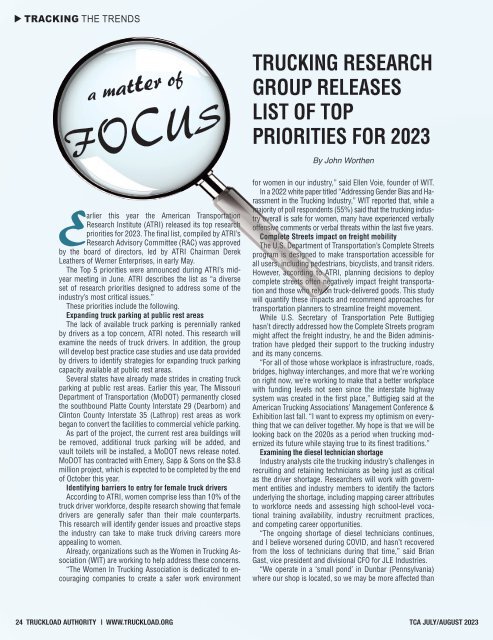TLA61_AllPages
Create successful ePaper yourself
Turn your PDF publications into a flip-book with our unique Google optimized e-Paper software.
Tracking The Trends<br />
a matter of<br />
FOCU S<br />
earlier this year the American Transportation<br />
Research Institute (ATRI) released its top research<br />
priorities for 2023. The final list, compiled by ATRI’s<br />
Research Advisory Committee (RAC) was approved<br />
by the board of directors, led by ATRI Chairman Derek<br />
Leathers of Werner Enterprises, in early May.<br />
The Top 5 priorities were announced during ATRI’s midyear<br />
meeting in June. ATRI describes the list as “a diverse<br />
set of research priorities designed to address some of the<br />
industry’s most critical issues.”<br />
These priorities include the following.<br />
Expanding truck parking at public rest areas<br />
The lack of available truck parking is perennially ranked<br />
by drivers as a top concern, ATRI noted. This research will<br />
examine the needs of truck drivers. In addition, the group<br />
will develop best practice case studies and use data provided<br />
by drivers to identify strategies for expanding truck parking<br />
capacity available at public rest areas.<br />
Several states have already made strides in creating truck<br />
parking at public rest areas. Earlier this year, The Missouri<br />
Department of Transportation (MoDOT) permanently closed<br />
the southbound Platte County Interstate 29 (Dearborn) and<br />
Clinton County Interstate 35 (Lathrop) rest areas as work<br />
began to convert the facilities to commercial vehicle parking.<br />
As part of the project, the current rest area buildings will<br />
be removed, additional truck parking will be added, and<br />
vault toilets will be installed, a MoDOT news release noted.<br />
MoDOT has contracted with Emery, Sapp & Sons on the $3.8<br />
million project, which is expected to be completed by the end<br />
of October this year.<br />
Identifying barriers to entry for female truck drivers<br />
According to ATRI, women comprise less than 10% of the<br />
truck driver workforce, despite research showing that female<br />
drivers are generally safer than their male counterparts.<br />
This research will identify gender issues and proactive steps<br />
the industry can take to make truck driving careers more<br />
appealing to women.<br />
Already, organizations such as the Women in Trucking Association<br />
(WIT) are working to help address these concerns.<br />
“The Women In Trucking Association is dedicated to encouraging<br />
companies to create a safer work environment<br />
Trucking research<br />
group releases<br />
list of top<br />
priorities for 2023<br />
By John Worthen<br />
for women in our industry,” said Ellen Voie, founder of WIT.<br />
In a 2022 white paper titled “Addressing Gender Bias and Harassment<br />
in the Trucking Industry,” WIT reported that, while a<br />
majority of poll respondents (55%) said that the trucking industry<br />
overall is safe for women, many have experienced verbally<br />
offensive comments or verbal threats within the last five years.<br />
Complete Streets impact on freight mobility<br />
The U.S. Department of Transportation’s Complete Streets<br />
program is designed to make transportation accessible for<br />
all users, including pedestrians, bicyclists, and transit riders.<br />
However, according to ATRI, planning decisions to deploy<br />
complete streets often negatively impact freight transportation<br />
and those who rely on truck-delivered goods. This study<br />
will quantify these impacts and recommend approaches for<br />
transportation planners to streamline freight movement.<br />
While U.S. Secretary of Transportation Pete Buttigieg<br />
hasn’t directly addressed how the Complete Streets program<br />
might affect the freight industry, he and the Biden administration<br />
have pledged their support to the trucking industry<br />
and its many concerns.<br />
“For all of those whose workplace is infrastructure, roads,<br />
bridges, highway interchanges, and more that we’re working<br />
on right now, we’re working to make that a better workplace<br />
with funding levels not seen since the interstate highway<br />
system was created in the first place,” Buttigieg said at the<br />
American Trucking Associations’ Management Conference &<br />
Exhibition last fall. “I want to express my optimism on everything<br />
that we can deliver together. My hope is that we will be<br />
looking back on the 2020s as a period when trucking modernized<br />
its future while staying true to its finest traditions.”<br />
Examining the diesel technician shortage<br />
Industry analysts cite the trucking industry’s challenges in<br />
recruiting and retaining technicians as being just as critical<br />
as the driver shortage. Researchers will work with government<br />
entities and industry members to identify the factors<br />
underlying the shortage, including mapping career attributes<br />
to workforce needs and assessing high school-level vocational<br />
training availability, industry recruitment practices,<br />
and competing career opportunities.<br />
“The ongoing shortage of diesel technicians continues,<br />
and I believe worsened during COVID, and hasn’t recovered<br />
from the loss of technicians during that time,” said Brian<br />
Gast, vice president and divisional CFO for JLE Industries.<br />
“We operate in a ‘small pond’ in Dunbar (Pennsylvania)<br />
where our shop is located, so we may be more affected than<br />
24 Truckload Authority | www.Truckload.org TCA JULY/AUGUST 2023

















